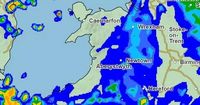Britain is bracing for a powerful autumn storm as the Met Office has issued widespread yellow weather warnings for heavy rain and strong winds, with forecasters warning of the potential for flooding, travel disruption, and even a small risk to life in coastal areas. The warnings, issued on October 21, 2025, cover much of southern and eastern England, the East Midlands, large swathes of Wales, and Yorkshire, and are set to take effect from late Wednesday, October 22, persisting through Thursday, October 23.
The culprit? A deepening area of low pressure, supercharged by a jet stream energized by a tropical typhoon far out in the Atlantic, is on a collision course with the UK. According to BBC Weather, this system, while not yet named by the Met Office, could still earn the title of Storm Benjamin or Storm Bram if meteorological agencies in France, Belgium, or the Netherlands deem its impact severe enough on the continent.
"A powerful jet stream will drive a deep low-pressure system across the UK on Thursday, bringing heavy rain and strong winds to many areas," the Met Office announced in a post on X, underscoring the seriousness of the approaching weather. Deputy Chief Meteorologist Dan Harris explained, "Low pressure moving across the south of the UK on Thursday will bring both a spell of heavy rain and areas of strong winds." He added, "The rain is expected to arrive from the southwest during Wednesday evening, before spreading northeast to many parts of England and Wales during Thursday, leading to difficult driving conditions and the risk of flooding in a few places. At the same time, winds are expected to pick up along south coastal areas in particular."
The yellow weather warning for rain extends from midnight to 9pm on Thursday, blanketing most of southern England, the East Midlands, parts of Wales, and Yorkshire. Rainfall totals are expected to reach 20-30mm widely, with some areas—particularly North Devon, Cornwall, and eastern England—potentially seeing 30-50mm or more by early Thursday morning. Localized flooding is a real concern, especially in these regions, and the Met Office has warned that some homes and businesses could be affected.
But it’s not just the rain that’s raising eyebrows. The wind is set to be a major player, with widespread gusts of 45-55mph expected and the possibility of 65mph along exposed coasts and headlands. In eastern England, gusts could locally surge to 75mph, especially late Thursday morning into the afternoon, according to The Independent. The yellow wind warning stretches from Brighton, London, Oxfordshire, and Norwich up to Hull and York, and is in effect from midnight to 9pm on Thursday. A separate warning covers Cornwall, Devon, Somerset, and parts of west Wales—including Swansea, Pembrokeshire, and Anglesey—from 4am to 6pm.
Such high winds bring a range of hazards. The Met Office has cautioned the public to expect power cuts, transport disruption, and even damage to buildings. There’s a small chance of injuries and danger to life, particularly along the coast, where large waves and beach material could be thrown onto seafronts, coastal roads, and properties. To minimize risks, forecasters advise residents to secure loose items outside their homes—think bins, garden furniture, trampolines, and sheds—and to avoid unnecessary travel during the worst of the weather.
Travelers are being told to brace for longer journey times or even cancellations across road, rail, air, and ferry services. The yellow weather warnings highlight the potential for significant disruption, with local authorities and emergency services on high alert. According to Sky News, the Met Office is urging everyone to prepare well before taking any journeys, drive safely, and stay indoors as much as possible during the peak of the storm.
This storm comes on the heels of Storm Amy, which battered the UK and Ireland earlier in October with winds reaching 100mph, leaving thousands without power and causing widespread closures of parks, railway lines, and ferry routes. While the current system is not expected to reach Amy’s ferocity, the memory of that disruption is fresh, and authorities are not taking any chances.
Interestingly, while the Met Office has not yet named this low-pressure system, the decision could fall to meteorological agencies in neighboring countries. As BBC Weather explains, if the Royal Netherlands Meteorological Institute, Météo France, or the Royal Meteorological Institute of Belgium decide the impacts will be more severe in their regions, they may name it Storm Benjamin or Storm Bram. The process for naming storms is a collaborative effort among several European agencies, aiming for consistency and clarity in public communications.
In terms of timing, the worst of the weather is expected to hit late Wednesday and persist through Thursday. Before then, conditions across the UK are forecast to be a mix of bright spells and showers, offering a brief respite before the storm’s arrival. By Friday, the system is expected to clear, leaving behind sunny spells and blustery showers, although strong winds may linger, particularly along the east and northeast coasts. The weekend looks set to turn colder as an Arctic Maritime airmass moves in, bringing the possibility of wintry showers over the Scottish mountains—a reminder that winter is just around the corner.
Despite the uncertainty surrounding the exact track and intensity of the low-pressure system, the Met Office emphasizes that adjustments to forecasts may be made at short notice. "It is worth noting that there is a greater than usual uncertainty surrounding the track and intensity of this low-pressure system, so the public should stay up to date with the latest forecasts and warnings as the situation evolves," said Deputy Chief Meteorologist Harris.
For now, the advice is clear: stay weather aware, keep an eye on official updates, and take sensible precautions. Whether the storm earns a name or not, its impacts will be felt across much of England and Wales, and communities are being urged to prepare for a challenging 24 hours. As always, the British weather keeps everyone guessing—but with the right information and a bit of caution, most can ride out the storm safely.


